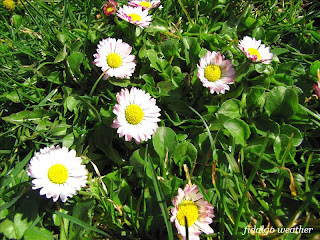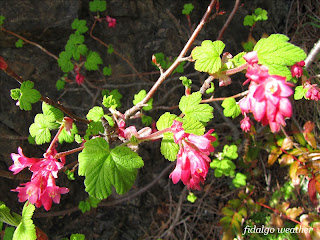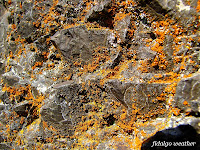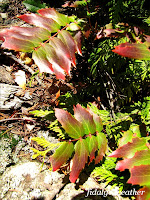A Day at the Park: Rosario Head Part 1
It is still March 23rd which delivered this beautiful, sunny day. We continue exploring the nature trails around Bowman Bay in Deception Pass State Park. This time, the destination is Rosario Head. We set off heading north from the parking lot and cross the picnic grounds. The park was built in the 1930's by men of the Civilian Conservation Corps. The CCC Interpretive Center is housed in a building that formerly served as a bathhouse and comfort station for CCC workers. Today, the lawns here were sparkling with little white flowers.
The lawn weeds are English Daisy (Bellis perennis) which are not natives. They were introduced from Europe. Man, those English really spread their seeds around the planet, didn't they? According to Pojar, the word daisy is derived from "day's eye" or "eye of the day," because the blossoms open and close in changing daylight.
Continue across the picnic grounds close to the shoreline to pick up the Rosario-Bowman Bay Nature Trail. It's about a mile out to Rosario. It begins with a fairly steep climb, but then levels off for a comfortable hike the rest of the way. One thing you'll discover is that it is noticeably drier here than along the Lighthouse Point Trail. The cliff side faces south and is open to the winds off the Strait of Juan de Fuca. The plant life reflects this more arid, sunnier and challenging microclimate.
Red Flowering Currant (Ribes sanguineum) is blooming now and can be seen all along the trail. This is a native shrub, but you can purchase cultivated varieties at nurseries. They thrive in the dry conditions afforded by the Olympic Rain Shadow. They are hardy and reliable plants for the Northwest native garden.
Another drought-loving native plant is the succulent Sedum spathulifolium. It appears to grow right out of the stone along the cliff face above the trail. Look for it in spots where it can bask in the sun. You'll find it in nurseries called Sedum 'Cape Blanco' so please don't try to collect any of these. This one is growing among at least three different kinds of Lichen.
Speaking of Lichens, you may discover more than a dozen different kinds growing along the trail. Look on rock faces and on tree trunks. I am finding it very difficult to identify the species names for Lichens.
More color is provided by Creeping Mahonia (Mahonia repens) a relative of Oregon Grape. Their leaves take on shades of reds and bronzes in the cold temperatures of winter. It is another nice addition to the native garden. It looks good among rocks and along paths, in sun or part shade. It grows very slowly and spreads by underground stems.
Halfway along the trail, we are high above Bowman Bay. In spots, the trail hugs the edge of the cliff, and the views are stunning. Madronas (Arbutus menziesii) also like the arid conditions here. They all appear to have suffered great stresses, taking on extreme contortions and twisting in their limbs. If a few conditions are met, however, they are tough competitors in the natural world.
From overhead in the trees came the shrill, chattering calls of Bald Eagles. This is courtship season which can be a very noisy affair. I tried, but could not spot them in the canopy. I find it interesting that wildlife in state parks like this seem to be more tolerant of humans than in other locations. You can often get surprisingly close and they don't seem to mind. This is particularly true of crows and gulls who have learned to exploit a life with people.
Waving in the breezes, Old Man's Beard is another Lichen that starts appearing in the branches of trees as we get close to Rosario Beach. You will only find it growing in old-growth forests. While the trees here are old, they are not as large as expected. The conditions here make this is a tough place for a tree to live and they don't all make it.
When we arrive at Rosario Beach, we are greeted by Ko-Kwal-alwoot, the Maiden of Deception Pass. This is a Samish story pole we have met here before. She was erected in 1983 to commemorate the Skagit County Centennial and to honor the Samish people. She reminds us to take good care of this beautiful place which was and is her home.
Rosario Beach is the site of the famous tidal pools. This is a field of volcanic rocks interspersed with pools which are exposed at low tide. Fifty-two years ago I camped here with a friend's family. I have vivid memories of exploring these pools. We had grown-ups with us who admonished us to step carefully and to look but not touch. I remember the multi-colored topshells and turbans, dog winkles and northern abalone. There were giant gumboot chitons, little mossy chitons, sea stars and sun stars in uncountable numbers. I remember the small purple sea urchins and the big red urchins with thick spines. I was a kid in his glory, a nature geek discovering all this sea life...
All that seems to be gone now. No sea stars, no urchins, no chitons, and only a sparse number of nondescript snails can be seen. Northern abalone are considered endangered, and appear to be extinct here. There are only barnacles, algae and an assortment of sea weeds. We have not honored Ko-Kwal-alwoot's story or respected her home.
On this visit today, there was an irritating child screaming to her grandfather to go and get a bucket so she could collect animals. I kept wondering why she was here and not in school. Grandpa obliged and therein lies the problem. He apparently had not read the sign and lacked the sensitivity of my erstwhile camping hosts. I wasn't concerned, since I knew the little darling would not find anything to collect. We may never have the opportunity to see anything like that here again.
We are now half way through this leg of the journey. Next time, we'll check out the sights from the top of Rosario Head, then hike back to the parking lot.














